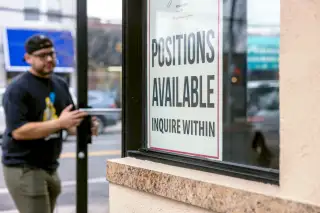Unemployment Hits Lowest Rate in Decades — and Wall Street Doesn't Know What to Make of It

The U.S. economy added 517,000 jobs in January as the unemployment rate fell to 3.4% — the lowest level in more than 50 years. While the numbers bode well for the jobs market and the economy in general, the stock market reaction was mixed.
Today's January jobs report came in much stronger than expected, beating the Wall Street consensus of a gain of 190,000 jobs.
Job growth was "widespread" in January, according to the Bureau of Labor Statistics, but it was strongest in leisure and hospitality, professional and business services and health care.
Why it matters
The economy added the most jobs in a month since July, indicating that labor is still in hot demand. Strong jobs numbers and low unemployment suggest workers continue to have leverage, and average hourly earnings were up 0.3% in January and 4.4% over the past year.
- The stock market dipped early Friday following the release of the job numbers, likely because the Federal Reserve partially bases its interest rate decisions on the state of the labor market. Strong jobs numbers could prompt the Fed to consider higher rates, which is the opposite of what investors want. By midday, stocks had mostly bounced back and the S&P 500 was basically flat on the day.
- After the Fed announced a smaller 25 basis point interest rate hike earlier in the week, Fed Chair Jerome Powell said, "The labor market continues to be out of balance. Labor demand substantially exceeds the supply of available workers."
- Seema Shah, chief global strategist of Principal Asset Management, says higher interest rates could be on the horizon: "It’s difficult to see how wage pressures can possibly soften sufficiently when jobs growth is as strong as this and it’s even more difficult to see the Fed stop raising rates and entertain ideas of rate cuts when there is such explosive economic news coming in."
Keep in mind
- Annual population corrections were made between the December and January jobs reports, which may have skewed the numbers, experts say. Still, the report is considered to be strong.
- "Don’t get too distracted by the size of the blowout payrolls number," says Callie Cox, U.S. investment analyst at eToro. "There are a bunch of revisions in play since it’s the beginning of the year. But it’s also obvious that we’re underestimating the strength of the job market."
Bottom line
The labor market appears to be tighter than experts thought, which is good news for workers but could be a bad signal for anyone hoping for lower interest rates.
More from Money:
Can ChatGPT Save You From the Agony of Writing a Cover Letter?
After a Strong Month for Stocks, Here's Where the Market Could Be Heading in February